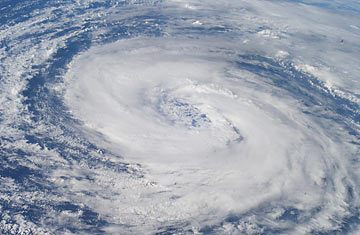
Back in the Pliocene era, between 5 million and 3 million years ago, the average global temperature was about 7°F warmer than it is today, yet atmospheric carbon dioxide levels were about the same. If carbon dioxide were the sole factor in warming, that wouldn't make any sense. It isn't, of course; there are several other contributors, including the brightness of the sun and the location of the continents (whose positions dictate, among other things, where ice caps can form) — but these were all pretty much the same in the Pliocene as well.
So what accounted for the higher global temperature? According to a new paper in Nature, one possible factor is hurricanes. Scientists have long suspected that global warming could make hurricanes more intense somehow, but the new study suggests the effect works both ways: tropical cyclones could help drive up temperatures in response. "We're suggesting that hurricanes could have created a permanent El Niño condition," says Yale's Alexey Fedorov, lead author of the study.
In the modern world, El Niño is a change in wind patterns and ocean currents that occurs every few years, bringing warmer water to the normally cool eastern Pacific; the result is major changes in storms and other weather effects, along with a temporary spike in global temperature. El Niño happened in 1998, for example, so if you were to take that year as a starting point for tracking global temperatures, you'd find that the following decade didn't see a lot of warming by comparison. (This is the origin of the myth that global warming has stopped.)
What might have happened back in the Pliocene, say Fedorov and his colleagues, is that an initial bout of global warming led to severer hurricanes — a distinct possibility supported by recent research published in Science and Nature Geoscience — and severer hurricanes led to more warming. Although most of us think about hurricanes in terms of their impact on the land, they also wreak havoc on the sea, churning the water like giant mixers and forcing warm surface waters deeper. When that occurs in the central Pacific, "the ocean responds by sending that water to the East," where it rises again close to the equator, says MIT's Kerry Emanuel, a co-author of the new study. This is more or less what happens during El Niño.
But while El Niño alone couldn't create long-lasting warming — since it's really just a rearrangement of the ocean's heat, not an overall increase — it could trigger an environmental feedback cycle that could. When you make the tropics warmer, "you also get more evaporation, so there's more water vapor in the atmosphere, which is a strong greenhouse gas," says Fedorov. So intense hurricanes can create conditions that warm the planet overall, leading to even more intense hurricanes, leading to more water vapor, and so on — a loop that could plausibly help explain the Pliocene's puzzling temperatures.
The case isn't ironclad. "I think it's interesting," says Penn State climate modeler Ryan Sriver, who wrote a commentary in Nature. "I'm not totally convinced yet."
One major reason for doubt: the simulation of ocean mixing in the computer models used by the paper's authors only crudely approximates what happens during actual hurricanes. Still, says Sriver, "we don't have a better way of doing it at this point, so this is a major step forward."
Fedorov agrees that the new paper doesn't solve the puzzle of a warmer Pliocene by itself. "This is just part of the story," he says. "It's still the subject of intense research. We describe one piece of the puzzle, but there are many more pieces."
Emanuel, for his part, calls it a plausible scenario. "But it does raise an intriguing proposition," he says. "It suggests that for a given combination of sunlight and atmospheric composition, it's possible for Earth to have more than one stable climate regime."
That in turn suggests that if we keep pouring CO2 into the atmosphere and warm the globe by several degrees, even a successful effort to bring carbon dioxide back down to today's levels may not restore the temperature. "You might," he says, "end up with a different climate."
Lemonick is the senior science writer at Climate Central.
